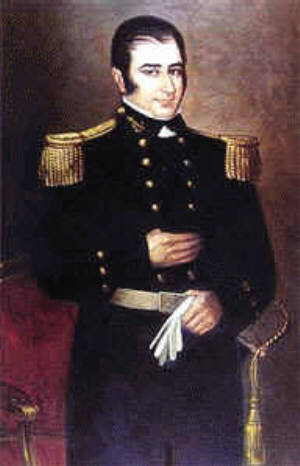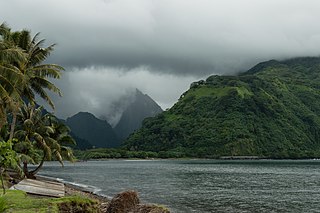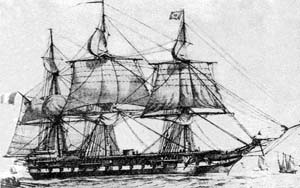Related Research Articles

Tahiti is the largest island of the Windward group of the Society Islands in French Polynesia. It is located in the central part of the Pacific Ocean and the nearest major landmass is Australia. Divided into two parts, Tahiti Nui and Tahiti Iti, the island was formed from volcanic activity; it is high and mountainous with surrounding coral reefs. Its population was 189,517 in 2017, making it by far the most populous island in French Polynesia and accounting for 68.7% of its total population; the 2022 Census recorded a population of 191,779.

Hippolyte or Hipólito Bouchard, known in California as Pirata Buchar, was a French-born Argentine sailor and corsair (pirate) who fought for Argentina, Chile, and Peru.

The Society Islands are an archipelago in the South Pacific Ocean that includes the major islands of Tahiti, Moʻorea, Raiatea, Bora Bora and Huahine. Politically, they are part of French Polynesia, an overseas country of the French Republic. Geographically, they form part of Polynesia.
Buenechea is the Spanish spelling of a Basque surname which also occurs in the variants Bonechea, Buonechea, Boenechea and Bonachea. The modern Basque spellings are Buenetxea and Bonetxea. This surname is not common; Buenecheas and Buenetxeas between them number fewer than 100 in the whole of Spain, for the most part located in Gipuzkoa, where diocesan records indicate only around 1000 persons have been born with this name and its variants in the 300-year period 1600–1900. It is made up of the elements "buen, bon" + "etxea" ('house'). The name therefore is originally related to "Goyenetch(e)", "Goyenech(e)" and "Go(i)enetxe".

Manuel Quimper Benítez del Pino was a Spanish Peruvian explorer, cartographer, naval officer, and colonial official. He participated in charting the Strait of Juan de Fuca and the Sandwich Islands in the late 18th century. He was later appointed a colonial governor in his native Peru at the beginning of the fight for independence there. He retired to Spain, but was able to return to Peru where he served as a naval officer in the new republic and pursued a literary career, publishing over 20 books about his experiences before his death there in Lima.

Tautira is a Polynesian beach village, valley, and point on the south-east coast of the island of Tahiti in the Pacific. It is part of the commune Taiʻarapu-Est. With a population of 2,527, it is located 49 kilometres southeast of the Tahitian capital of Papeete on the coast of Tautira Bay, at the end of what is the largest valley of the Taiarapu Peninsula. Domingo de Bonechea visited the area in 1772 and attempted to spread Christianity here; James Cook landed at Tautira Bay during his voyage. Robert Louis Stevenson referred to the village as “The Garden of the World”, staying here to recover from illness in 1886. The village contains a Catholic church.

Manuel de Amat y Junyent, OSJ, OM was a Spanish military officer and colonial administrator. He was the Royal Governor of the Captaincy General of Chile from December 28, 1755, to September 9, 1761, and Viceroy of Peru from October 12, 1761, to July 17, 1776.

Raivavae is one of the Austral Islands in French Polynesia. Its total land area including offshore islets is 17.9 km2 (6.9 sq mi). At the 2022 census, it had a population of 900. The island is of volcanic origin, and rises to 437 metres (1,434 ft) elevation at Mont Hiro.

Tatakoto is an atoll in the Tuamotu group in French Polynesia.

José de Bustamante y Guerra was a Spanish Navy officer, explorer and politician.

Tauere Atoll or Taouere, also known as Te Putua, is a small atoll of the central Tuamotu Archipelago in French Polynesia. It is located 85 kilometres northwest of Hao Atoll's westernmost point.

Felipe González de Ahedo, also spelled Phelipe González y Haedo, was a Spanish navigator and cartographer known for annexing Easter Island in 1770.

BAP Apurímac was the second steam frigate of the Peruvian Navy, built in England in 1855 along with the steam schooners Loa and Tumbes as a part of a major build-up of the Navy during the government of President José Rufino Echenique. A veteran of two wars and many internal conflicts, due to her age, she served as training ship in Callao port from 1873 until January 17, 1881, when she was scuttled along with the rest of the Peruvian Navy to prevent capture by Chilean troops who had occupied the port after the defeat of the Peruvian Army in the battles of San Juan and Miraflores.

Águila was the first naval vessel of the Chilean Navy. She was later renamed Pueyrredón.

The First Chilean Navy Squadron was the heterogeneous naval force that terminated Spanish colonial rule in the Pacific and protagonized the most important naval actions of in the Latin American wars of independence. The Chilean revolutionary government organized the squadron in order to carry the war to the Viceroyalty of Perú, then the center of Spanish power in South America, and thus secure the independence of Chile and Argentina.
Matavai Bay is a bay on the north coast of Tahiti, the largest island in the Windward group of French Polynesia. It is in the commune of Mahina, approximately 8 km east of the capital Pape'ete.
Agustín Manuel Hipólito Orella Macaya, known simply as Manuel Hipólito Orella, was a Chilean naval officer who made a career in the Chilean Navy. He was one of the first Chilean midshipmen who entered the nascent navy in 1818. He joined the First Chilean Navy Squadron and participated in the naval war for the independence of Chile and Peru. Likewise, also spent time in the Chilean Army in the infantry branch. Furthermore, he held several important positions in the navy until his death in 1857.

Manuel Antonio Villavicencio Freyre was a prominent Peruvian Navy officer, who participated in the War of the Pacific. He also served as a Senator.

Nicolás Federico Portal was a Peruvian captain and politician during the War of the Pacific. He is known for being the captain of the BAP Unión throughout the war.
Joaquín Zarauz y de Santander (1756–1810) was a Spanish naval officer.
References
- 1 2 3 4 Salmond, Anne (2010). Aphrodite's Island . Berkeley: University of California Press. pp. 236-256. ISBN 9780520261143.
- "The 18th Century Sailors", Tahiti Guide.
- Amaru, G. "Tahití hubiera podido ser española", Vivat Academia, No. 1 (Dec. 2005-Jan. 2006).
- Colaboradores de Wikipedia. "Expediciones españolas a Tahití", Wikipedia, La enciclopedia libre.
- Ortiz Sotelo, Jorge. "Expediciones peruanas a Tahití, siglo XVIII." Derroteros de la Mar del Sur, No. 13 (2005), 95-103.
- Riullop, Vicenç. La isla anacreóntica: Las referencias clásicas de los navegantes de la Ilustración. 2004.